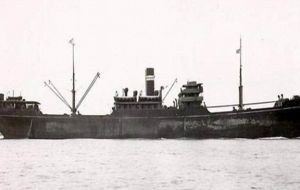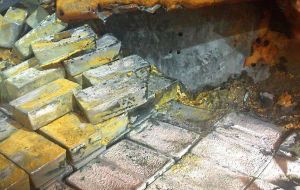MercoPress. South Atlantic News Agency
Treasure explorers recover 61 tons of silver bullion in waters three miles deep
 Steel hulled SS Gairsoppa and its valuable cargo was sank in February 1941
Steel hulled SS Gairsoppa and its valuable cargo was sank in February 1941 Odyssey Marine Exploration said it has recovered more than 61 tons of silver bullion this month from a depth of nearly three miles. This recovery of bullion from the SS Gairsoppa, a 412-foot steel-hulled British cargo ship that sank in February 1941, consists of 1,574 silver ingots weighing about 1,100 ounces each or almost 1.8 million troy ounces in total, sets a new record for the deepest and largest precious metal recovery from a shipwreck. The silver has been transported to a secure facility in UK.
Including the silver recovered in 2012, Odyssey has now recovered 2,792 silver ingots from SS Gairsoppa or more than 99% of the insured silver reported to be aboard the Gairsoppa when she sank. Under the terms of Odyssey's contract with the U.K. Department for Transport, which follows standard commercial practices, Odyssey will retain 80% of the net salved value of the cargo. The contract was awarded to Odyssey following a competitive tender process.
Sources, including Lloyd's record of War Losses, indicate additional uninsured government-owned silver may have been aboard the SS Gairsoppa when she sank, but to date no uninsured silver has been located.
“This was an extremely complex recovery which was complicated by the sheer size and structure of the SS Gairsoppa as well as its depth nearly three miles below the surface of the North Atlantic,” commented Greg Stemm, Odyssey's chief executive officer. “To add to the complications, the remaining insured silver was stored in a small compartment that was very difficult to access.
”The recovery of more than 99% of the insured silver cargo under these adverse conditions is a testament to the skill and ingenuity of the offshore team led by Senior Project Managers, Andrew Craig and Ernie Tapanes. The expertise demonstrated in implementing this challenging project continues to be applied as we undertake other modern shipwreck projects, deep-ocean mineral exploration and our best-in-class deep-ocean archaeological work on historic shipwrecks.“
Mark Gordon, Odyssey's president and chief operating officer added, ”The ability of our team to deliver on our planned objectives underscores our experience and the tremendous determination of our team. We have accomplished a world-record recovery at a depth never achieved before. We're continuing to apply our unique expertise to pioneer deep-ocean projects that result in the discovery and recovery of lost cultural heritage, valuable cargoes and important and needed natural resources.”
The recovery operations were conducted from the 291-foot Seabed Worker mobilized with 5,000 meter depth-rated remotely operated vehicles (ROVs) and heavy launch and recovery systems. Additional specialized deep-ocean equipment was mobilized by Odyssey on the ship for the project. The Seabed Worker has returned to sea to continue Odyssey's 2013 North Atlantic Expedition, which includes the SS Mantola, a 450 foot British-flagged steamer lost in 1917 and found in 2011 by Odyssey, as well as the Gairsoppa. The Mantola reportedly carried approximately 600,000 troy ounces of silver insured under the U.K War Risk insurance program. (odysseymarine.com)


![“Working directly with President [Donald] Trump and Congress, we accomplished what no one else could,” Patel stressed](/data/cache/noticias/108417/130x80/fbi.jpg)


Top Comments
Disclaimer & comment rules-

-

-

Read all commentsNo wonder TMBOA wanted ALL the Atlantic for The Dark Country!
Jul 24th, 2013 - 05:19 pm 0Oh, yes!
Jul 24th, 2013 - 06:39 pm 0Takes you back to the days of Blackbeard.
80% seems like a hefty fee, until you realise the work that Odyssey have done & the fact that 20% for the original owners(UK Govt?) is better than 0%.
Jul 24th, 2013 - 07:54 pm 0A pity we don't have the technology to economically raise all steel wrecks as the scrap value would be enormous plus removing shipping hazards from shallower waters.
Also cleaning up our mess from Mother Earth.
Commenting for this story is now closed.
If you have a Facebook account, become a fan and comment on our Facebook Page!